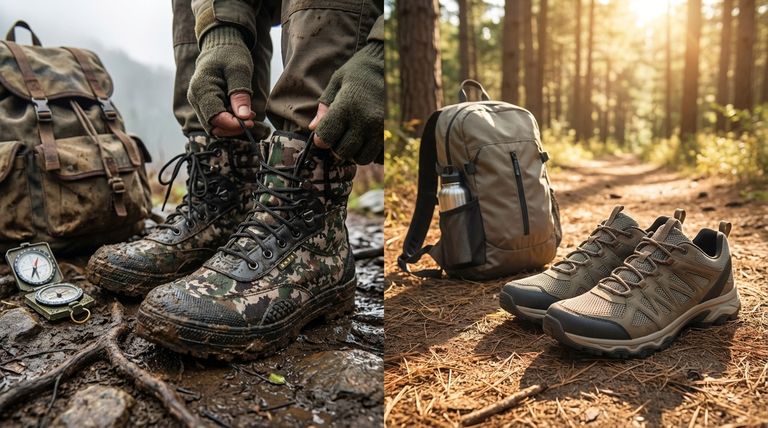Yes, there are distinct downsides to hunting boots. While they are exceptional tools for their specific purpose, their highly specialized design creates disadvantages in other contexts. The most significant drawbacks are their high cost, substantial weight, and the mandatory break-in period required for many high-quality models.
The very features that make hunting boots superior for rugged, off-trail use—heavy-duty materials, robust waterproofing, and insulation—are the direct source of their primary weaknesses: a lack of versatility, significant weight, and a higher price point.

The Core Trade-off: Specialization vs. Versatility
Hunting boots are engineered for a single, demanding purpose: protecting your feet in harsh, unpredictable environments. This specialization inherently involves trade-offs that make them less suitable for general use.
The Burden of Weight
A key characteristic of hunting boots is their sturdy, heavy construction. This weight comes from durable materials like thick leather, protective rubber rands, dense insulation, and aggressive outsoles.
While this construction provides critical protection and support, the added weight can lead to fatigue over long treks on less demanding terrain.
The Investment of Cost
High-quality hunting boots are expensive. The price reflects the premium materials, such as full-grain leather and Gore-Tex waterproofing membranes, as well as the complex construction needed for long-term durability.
This cost can be a significant barrier, especially when compared to more general-purpose hiking or work boots.
The Commitment of a Break-in Period
Many of the most durable hunting boots, particularly those made from natural leather, require a significant break-in period.
During this time, the stiff materials slowly mold to the shape of your feet. This process can be uncomfortable initially but eventually results in a custom, supportive fit. Synthetic boots, by contrast, often require less break-in time but may not offer the same long-term durability.
The Challenge of Breathability
The focus on waterproofing and insulation can compromise a boot's breathability. Leather and heavy synthetic materials do not vent moisture as well as lighter fabrics.
In warmer conditions or during strenuous activity, this can lead to excessive sweating, which is not only uncomfortable but can also cause blisters and other foot problems.
Understanding the Trade-offs: Hunting Boots vs. Alternatives
To fully appreciate the downsides, it's helpful to see how hunting boots compare to other types of footwear designed for different goals.
Compared to Hiking Boots
Standard hiking boots typically prioritize being lightweight and flexible. They are designed for established trails and often offer better breathability, making them more comfortable for fast-paced, high-mileage days in moderate conditions.
Compared to Tactical Boots
Tactical boots are built for agility and a wide range of motion. They are significantly lighter and more flexible than hunting boots, making them ideal for situations where speed is more critical than maximum protection from the elements.
Compared to Everyday Footwear
For daily use, a hunting boot is simply overkill. Its weight, stiffness, and insulation make it cumbersome and uncomfortable for walking on pavement or wearing indoors. They are specialized equipment, not casual shoes.
Making the Right Choice for Your Needs
Choosing the right boot means aligning its features with your specific goals. Understanding the inherent downsides of a hunting boot is key to making an informed decision.
- If your primary focus is maximum durability in rugged, off-trail terrain: The weight and break-in period of a quality leather hunting boot are a necessary investment for its protection.
- If your primary focus is hunting in mild weather on clear trails: A lighter, more breathable synthetic hunting boot or even a sturdy hiking boot may be a more comfortable and practical choice.
- If your primary focus is warmth in extreme cold: The downsides of cost and weight are secondary to the essential need for high levels of insulation and robust waterproofing.
- If your primary focus is agility and speed: A dedicated tactical boot offers the flexibility and low weight that a traditional hunting boot cannot provide.
Ultimately, selecting the correct footwear is about choosing the right tool for the job.
Summary Table:
| Disadvantage | Key Impact | Ideal Use Case |
|---|---|---|
| High Cost | Significant upfront investment | Rugged, long-term use in harsh conditions |
| Heavy Weight | Increased fatigue on long treks | Off-trail terrain requiring maximum protection |
| Break-in Period | Initial discomfort before optimal fit | Hunting boots made from durable, natural leather |
| Low Breathability | Can cause sweating and blisters | Cold, wet environments where warmth is critical |
Need the Right Boot for Your Specific Needs?
As a large-scale manufacturer, 3515 produces a comprehensive range of footwear for distributors, brand owners, and bulk clients. Our production capabilities encompass all types of shoes and boots, from rugged hunting boots to lightweight tactical and hiking footwear. We can help you source or create the perfect boot that balances durability, comfort, and cost-effectiveness for your target market.
Let's discuss your requirements: Contact our expert team today to find the ideal footwear solution.
Visual Guide

Related Products
- Wholesale High-Traction Camo Boots - Custom Manufacturer for Brands
- Factory-Direct Wholesale Canvas Boots with High-Traction Rubber Soles
- Durable Spiked Camouflage Boots Wholesale & Factory Production
- Safety Footwear Wholesale Manufacturer for Custom OEM/ODM Production
- Wholesale Waterproof Tactical Boots Custom Suede & High-Traction Soles
People Also Ask
- What benefits do the men's camo boots provide? Superior Protection & Comfort for Demanding Terrain
- How did camouflage use develop during the World Wars? From Artistic Disruption to Scientific Concealment
- Why might wearing multiple pairs of socks be counterproductive? Avoid This Common Cold-Weather Mistake
- What is the name of the new boot model mentioned in the article? Introducing the Boots Original Camo Red Desert
- How is PVC produced? From Salt & Gas to a Versatile Polymer



















